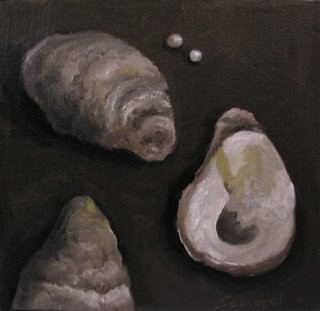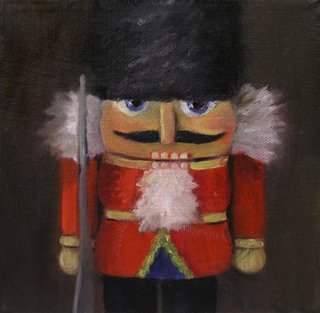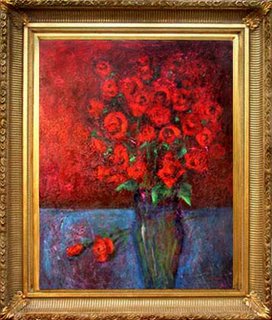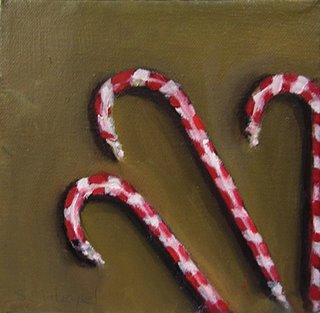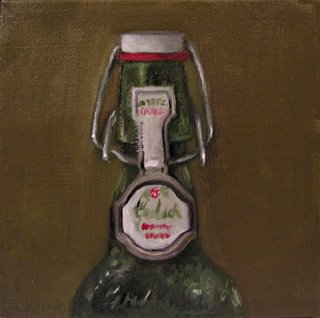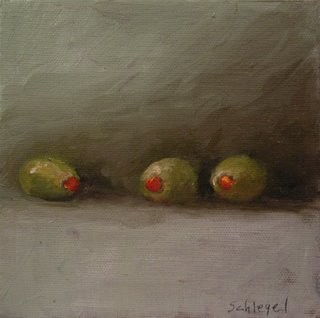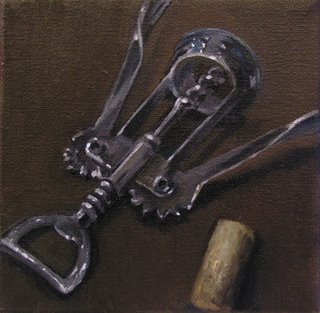 Pabst Blue Ribbon • this painting is sold
Pabst Blue Ribbon • this painting is sold
I am, on the average, very particular with the beer that I enjoy. A favorite of mine is Celebration Ale by Sierra Nevada ... and the standby IPA as well. So, when asked to paint a Pabst Blue Ribbon can, I was slightly apprehensive. I bought a six-pack from Lehigh Pizza in Bethlehem, and had my first taste of Pabst in a very long time. I will say that this crisp, cold, refreshing beer would be a wonderful choice at an outdoor, hot summer party. And, I really like the can design.
The original brewery was founded as Best Brewery in 1844 by the immigrant German brewer Jacob Best. He started on Chestnut Street Hill in Milwaukee with a capacity of 18 barrels. Later, in 1863, Frederick Pabst, a steamship captain, bought a share in Best and Company, by which time the brewery was already selling a lager which they began bottling in 1875 under the name Best Select.
In 1889 the name of the brewery was changed to Pabst Brewing Company. In 1893 Pabst's beer won a hotly contested competition at the World's Columbian Exposition in Chicago. Afterward, the name Pabst Blue Ribbon became firmly entrenched within American beer vocabulary.
The year 1895 brought additional honors when Pabst became the first U.S. brewer to hit the million-barrel per year mark. The beer was so successful that Pabst began ordering millions of yards of blue ribbon. One factory in 1902 worked around the clock for nearly a year to complete a contract for 10 million yards of ribbon.
When Fredrick Pabst died on New Year's day of 1904 he left control of the business to his sons Fred Jr. and Gustav. In 1906, the Pabst Brewing Company first began to use caps on bottles instead of corks. Growth continued up to Prohibition when all alcohol production stopped. Fred Jr. and Gustav successfully guided the company through the discouraging years of prohibition by switching to malt syrup, tonic, cheese and near beer.
When the beer returned in 1933, minus the blue ribbon, it quickly became a national brand brewed in several locations across the country. In 1935, Pabst was the second brewer, following Krueger Beer, to put beer in cans. Called "Export", the cans came with a picture of a can opener on the side, with opening instructions.
During World War II all cans of Pabst Blue Ribbon were painted a military green and were exclusively made for the troops because of tin rationing.
In 1958, with an annual production of 3.9 million barrels, Pabst Blue Ribbon had now sold a total of 100 million barrels since first being brewed, an event commemorated by adding the red stripe to the logo. Annual sales figures climbed each year, helped by Pabst cutting the price of the beer, until it reached a record high of 18 million barrels in 1977. In 1997 one of the saddest chapters in Pabst's proud history was written. Facing the cold reality of bleak financial performance at its flagship brewery, it closed the long obsolete Milwaukee facility. A century-and-a-half after its birth the last barrel rolled out its fabled doors.
Economics eventually forced closure of all of Pabst's breweries in 2001, including my home town of Allentown, PA., though the transfer of production to the Miller Brewing Company is a continuation of sorts because Miller was founded in the Plank-Road Brewery which had been established by some members of the Best family, just after the original Best brewery was founded.
In 2004, Students at Oregon State University approached marketers at Pabst Brewing Company. Pabst agreed to sponsor an unofficial fratenity based on Pabst Blue Ribbon's famous letters. Pi Beta Rho quickly became the envy of many Oregon State Students.Pabst sales executives noticed that sales in Portland, Oregon of PBR were growing, without any marketing or explanation. Further research found a local Portland bar The Lutz had changed its offering to Pabst after a local beer went off the market. It was found that the local community was made up of a large counterculture along with working class people, who had adopted Pabst as their brew. Soon other bars in the area started to offer Pabst as their less expensive beer (Portland being famous for its high-end microbrews). From Portland PBR has become popular again including San Francisco, Seattle (cities known for their countercultures), Richmond, Minneapolis and Omaha (cities with a respectable counterculture, but also associated with the working class).I have heard that Pabst Blue Ribbon is also a favorite beer with many college students in the Lehigh Valley area of Pennsylvania.
In the 2006 Brewery and Brewer of the Year Awards, Pabst Brewing Company, Woodridge, Il, won for 'Large Brewing Company and Large Company Brewer of the Year! Congratulations!
Give me a Sierra Nevada anytime ... but on a hot summer day, feel free to pass the Pabst.
If you would like to purchase this 6" x 6" oil painting on stretched canvas, please email me. This painting is priced at $100.00 plus s/h.
info@annelizabethschlegel.com
Thank You!







